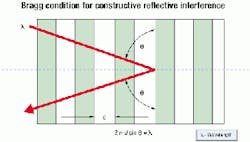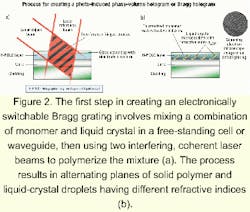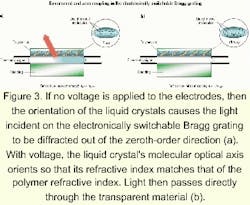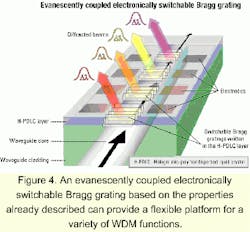Recent advances in ESBGs make them an optimal technological fabric for WDM components.
ALLAN ASHMEAD, DigiLens Inc.
The migration of telecom networks to all-optical networks (AONs) obviously necessitates the need for all-optical components. WDM optical components that leverage the same basic technology to perform different functions such as attenuation, dynamic spectral equalization, optical add/drop multiplexing, variable optical attenuation, small optical crossconnecting, and 1xn free-space switching will enable the evolution of WDM systems to AONs with fewer components, more speed, and even larger cost savings.
One technology in particular, electronically switchable Bragg gratings (ESBGs), provides for a versatile all-optical technological fabric from which different WDM components can be woven from the same basic process.
ESGBs work through the process of Bragg diffraction, a phenomenon that has been around for almost 100 years, an eternity in the telecom industry. Sir William Lawrence Bragg first described mathematically how light is diffracted from periodic structures. Periodic structures, on the order of the size of the wavelength of the diffracting light, produce periodic changes in the amplitude, phase, or both the amplitude and phase of an incident beam. Physically, many beams are generated by the interaction of incident light with the periodic structures. Constructive interference (i.e., the addition of similarly phased beams) leads to the various diffraction orders.The periodic structure in many telecom components using Bragg diffraction is created by inducing variations in the index of refraction of the material, similar to FBGs. Physically, it is as if multiple spaced reflecting planes created by the index variations each reflect a portion of the incident beam, and only those reflected portions in phase constructively interfere with each other to produce the reflected beam.
Periodic structures can also be created by spatially distributing liquid-crystal nanodroplets in a constrained polymer matrix. A composite electro-optical medium of this nature is called a holographic polymer dispersed liquid crystal (H-PDLC). Since H-PDLCs contain liquid crystals exhibiting an electro-optic effect, their periodic structure can be altered or turned on or off by the application of an electrical field. Under these conditions, H-PDLCs are generally referred to as electronically switchable Bragg gratings.
ESBGs are created by first mixing a combination of monomer and liquid crystal in a free-standing cell or waveguide. Two interfering, coherent, laser beams are used to polymerize this mixture (see Figure 2). The interfering laser beams create a fringe pattern in the monomer and liquid-crystal mixture instigating a photo-initiated polymerization process in which liquid-crystal droplets preferentially form in the dark fringes of the interference pattern.The diffusion process causes a phase separation of the liquid crystal into two regions of differing refractive indices. One region contains only polymer and the other, in the dark fringes, a mixture of polymer and liquid crystal. The resulting combination is essentially a photo-induced phase-volume hologram or Bragg hologram. The period of the interference pattern thus determines the spatial frequency of the ESBG periodic structure.
To exploit the electro-optic property of the liquid crystal, electrodes are deposited onto the cell or waveguide walls. If no voltage is applied to the electrodes, then light incident on the ESBG is diffracted out of the zeroth-order direction. An applied AC voltage orients the liquid-crystal molecular optical axis such that its refractive index now matches that of the polymer refractive index. In essence, the ESBG periodic structure "vanishes" upon the application of the electrical field due to index matching, which then results in only a zeroth-order. Light is simply transmitted through the transparent material (see Figure 3).
Although H-PDLC uses liquid crystals, its composite polymer/liquid-crystal properties offer superior performance over bulk liquid crystals in certain important optical areas such as scattering, birefringence, and switching speed. That is due to the small size of the liquid-crystal droplets, which makes them excellent optical candidates for forming Bragg grating structures. They exhibit low scattering and absorption even in the near-infrared spectrum. Their diffraction efficiencies rival those of the best photopolymer holographic materials.
Typical WDM systems require a variety of functional components to modulate, detect, route, and control light throughout the network. Signals must be attenuated, dynamically spectrally equalized, optically added and dropped, optically attenuated, and optically "cross" connected and switched within the network. Fundamental ESBG technology provides a basic and versatile component fabric that can be used to implement these different functions (see Figure 4).For example, dynamic spectral equalization is a wavelength management process where the powers of individual WDM signals or channels must be kept adequate and approximately the same as the light propagates through the network. Each wavelength constitutes a channel, and spectrally unbalanced channels will lead to decreased signal-to-noise ratio and bit-error rate. That is especially important in erbium-doped fiber amplifier (EDFA) systems, the most generally used optical amplifiers whose nonlinear gain leads to unbalanced WDM channels. ESBGs enable Fourier filtering to spectrally equalize WDM signals by splitting the EDFA gain curve into small (3-6-nm), individually spaced spectral windows within which the gain curve is adjusted independently and dynamically.
ESBGs can also be used in grating-assisted, planar-waveguide Mach-Zehnder coupled optical add/drop multiplexers/ demultiplexers (OADMs). Figure 5 (see reference 2) illustrates an ESBG-based OADM in which both arms of a Mach-Zehnder interferometer have ESBG resonant gratings at the wavelength of interest, λ4, making it possible to drop that channel. By electronically erasing the gratings, all wavelengths pass through and remain unaltered.Figure 5. In this optical add/drop multiplexer, both arms of the Mach-Zehnder interferometer have electronically switchable Bragg gratings at the wavelength of interest, λ4, which enables the device to drop that channel.
Due to the symmetry of the device, it is correspondingly possible to add as well as drop simultaneously, providing the full OADM functionality. The placing of additional matched pairs of gratings with different resonant wavelengths would permit the OADM to drop or add several different wavelength channels at once.
Channel crossconnecting (i.e., routing signals from individual input ports to one or more selected output ports) is a required function in communication systems. ESBGs allow this function to be implemented in the optical rather than electronic domain, eliminating the substantial cost associated with electronic/ optical conversion. Optical space switching can be implemented using ESBGs to generate phase delays in phased-array planar-waveguide structures to build a number of simple switching elements.
ESBGs provide a versatile technological fabric from which different WDM components can be woven from the same basic process. ESBGs eliminate additional mux/demux layers by integrating this function within the component. The ESBG's versatile technology can be used to create components necessary in AONs for dynamic spectral equalization, optical add/drop multiplexing, variable optical attenuation, small optical crossconnecting, and 1xn free-space switching.
Furthermore, ESBGs are an attractive material technology because of their solid-state nature. Their polymer-based material structure inherently exhibits low material polarization-dependent loss, and the smaller liquid-crystal molecular structure enables fast switching speeds on the order of 50 microsec.
The ESBG's wavelength selectivity provides a multifunctional, scalable waveguide platform. By combining multiple functions within the same device whose underlying technology can be used for different WDM components, ESBGs will enable the evolution of WDM systems to AONs with fewer components, more speed, and even larger cost savings than existing WDM telecommunications technology.
Allan Ashmead is vice president of business development at DigiLens Inc. (Sunnyvale, CA).
- "Holographic PDLC for Photonic Applications," SPIE proceedings, Vol. 4137, Liquid Crystals V, Ed. I.C. Khoo, 2000.
- A. Othonos and K. Kalli, Fiber Bragg Gratings, Artech House Publishing.



